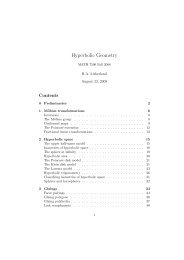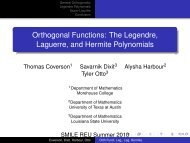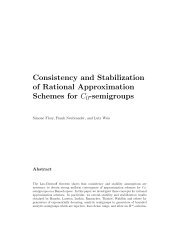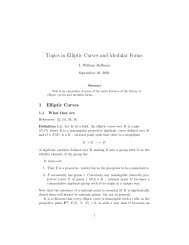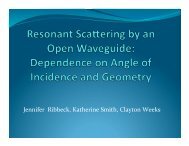Baire Category Theorem
Baire Category Theorem
Baire Category Theorem
Create successful ePaper yourself
Turn your PDF publications into a flip-book with our unique Google optimized e-Paper software.
Math 7311 <strong>Baire</strong> <strong>Category</strong> <strong>Theorem</strong><br />
<strong>Baire</strong> <strong>Category</strong> <strong>Theorem</strong><br />
Recall that a set ∈ ℝ is called if it canbe written as a countable intersection<br />
of open sets; i.e.<br />
= ∩,<br />
where each is open. A set is called a if it can be written as a countable<br />
union of closed sets; i.e.<br />
= ∪,<br />
where each is closed.<br />
What sets are and what sets are ? This is not an easy question to answer<br />
in general.<br />
Problem 1. Show that the rationals ℚ is a and the irrationals is a .<br />
Can the rationals also be expressed as a ? Questions such as these dance<br />
around an idea about the size of sets. This set of notes discusses this issue in a<br />
more general context and culminates with the <strong>Baire</strong> <strong>Category</strong> <strong>Theorem</strong> that has far<br />
reaching implications in analysis.<br />
Most of these notes consist of a sequence of easy problems that you should work<br />
out. I have tried to keep them simple and concise.<br />
Let’s begin with the problem I asked about: The rationals ℚ, is it a ? The<br />
answer is no! Consider the following problems that lead to a proof.<br />
Problem 2. Suppose {} is a countable collection of open sets and = ∩. Show<br />
that we can write = ∩ where is open and +1 ⊂ . (Hint: Let 1 = 1,<br />
2 = 1 ∩2, etc.)<br />
Problem 3. If is a non empty open set there is a closed interval = [,], < <br />
with ⊂ 0.<br />
Definition 4. A set is dense in ℝ if ¯ = ℝ.<br />
Problem 5. A set is dense in ℝ if and only if ∩ ∕= ∅ for all non empty open<br />
intervals .<br />
Problem 6. If ⊂ and is dense so it .<br />
Problem 7. Suppose 1 and 2 are dense and open. Then 1∩2 is dense and open.<br />
Problem 8. Suppose {} is a countable collection of open dense sets. Then ∩ is<br />
not empty.<br />
Math 7311 1
Math 7311 <strong>Baire</strong> <strong>Category</strong> <strong>Theorem</strong><br />
Proof. First, note that density is essential here. For example, = (0, 1)<br />
has empty <br />
intersection.<br />
ByProblems 2and7(andthehint forproblem1) wecanassume that+1 ⊂ ,<br />
for all . Let 1 = [1,1], 1 < 1, be a closed set in 1. Since 2 is open and<br />
dense, 2 ∩ (1,1) is open and non empty. Let 2 = [2,2], 2 < 2, be a closed<br />
set in 02 ∩(1,1). Then 2 ⊂ 1. Since 03 is open and dense, 3 ∩(2,2) is open<br />
and non empty. Let 3 = [3,3], 3 < 3, be a closed set in 3 ∩ (2,2). Then<br />
3 ⊂ 2 ⊂ 1. We continue in this way to create a decreasing sequence of closed sets<br />
{}. By Exercise 3.1 p33 of Richardson ∩ ∕= ∅. (This proposition is grounded in<br />
the completeness of the real line.) But since ⊂ it follows that ∩ ∕= ∅.<br />
Remark 9. The proof of the <strong>Baire</strong> <strong>Category</strong> theorem that we prove below contains<br />
ideasthataresimilartotheproofgivenabove. Moreover, the<strong>Baire</strong><strong>Category</strong>theorem<br />
implies that the intersection of dense open sets is not only not empty but dense, and<br />
in fact ‘very’ dense.<br />
Problem 10. The rationals ℚ is not a .<br />
Proof. Here is an outline. Fill in the gaps. We proceed by assuming ℚ is a .<br />
Suppose ℚ = ∩. Show the following:<br />
1. We may assume +1 ⊂ .<br />
2. Each is dense.<br />
3. Let 1,2,... be an enumeration of the rationals. Define = ∖{}. Then<br />
is open and dense.<br />
4. ∩ = ∅, a contradiction.<br />
Nowhere dense sets<br />
We now turn to a slightly more general setting that the one above.<br />
Definition 11. A set is said to be nowhere dense in ℝ if for every interval <br />
there is a subinterval ⊂ such that<br />
∩ = ∅.<br />
Math 7311 2
Math 7311 <strong>Baire</strong> <strong>Category</strong> <strong>Theorem</strong><br />
In a certain sense a nowhere dense set is ‘small’ in that its complement has lots<br />
of open intervals in it. But beware, a nowhere dense set can have uncountably many<br />
elements in it. We’ll get to that later. For now consider the following examples.<br />
Problem 12. Show the following sets are nowhere dense.<br />
1. A finite set<br />
2. The set {} if lim = ∈ ℝ.<br />
3. The set of natural numbers 1,2,3,....<br />
4. The complement of an open dense set.<br />
Problem 13. Show that the rationals, ℚ, is not nowhere dense.<br />
Problem 14. Show that any subset of a nowhere dense set is nowhere dense.<br />
Problem 15. If and are nowhere dense show that ∪ is nowhere dense.<br />
Problem 16. A finite union of nowhere dense sets is nowhere dense.<br />
Problem 17. Give an example of a set which is a countable union of nowhere dense<br />
sets that is not nowhere dense.<br />
Problem 18. If is nowhere dense then ˜ , the complement of , is dense.<br />
Problem 19. Give an example of a dense set whose complement is not nowhere dense.<br />
Problem 20. A set is nowhere dense if and only if ¯ contains no open intervals.<br />
Some Definitions<br />
Definition 21.<br />
1. We say that a set is of first category if it is the countable union of nowhere<br />
dense sets.<br />
2. We say a set is of second category if it is not first category.<br />
3. We say a set is residual if it is the complement of a set of first category.<br />
Agreed, these terms are not very inspiring. They are historical and here to stay.<br />
As we will see first category sets are ‘small’ and second category sets are ‘big’. For<br />
this reason, some have said that a first category set should be called meager. I will<br />
not use this term. The definition of residual does not, a priori, exclude the possibility<br />
Math 7311 3
Math 7311 <strong>Baire</strong> <strong>Category</strong> <strong>Theorem</strong><br />
that it be of first category. However, The <strong>Baire</strong> category theorem that follows will<br />
imply that this is not the case: residual sets are second category.<br />
Keep in mind the following basic example. The set of rationals, ℚ, is of first<br />
category because if 1,2,... is an enumeration of ℚ then ℚ = ∪{} and each {}<br />
is nowhere dense. The set of irrationals is residual. Both sets are dense in ℝ but the<br />
irrationals is much larger as we will see below.<br />
Problem 22. Any countable set is of first category.<br />
Problem 23. A countable union of first category sets is first category.<br />
Problem 24. A countable intersection of residual sets is residual. (Hint: this follows<br />
from the previous problem.)<br />
<strong>Theorem</strong> 25 (The <strong>Baire</strong> <strong>Category</strong> <strong>Theorem</strong>). A residual set is dense.<br />
Proof. The basic idea of the proof is very similar to that of Problem 8. Let be a<br />
residual set. Then ˜ is a countable union of nowhere dense sets:<br />
˜ = ∪,<br />
where is nowhere dense. We thus have that<br />
= ∩ ˜ .<br />
To show is dense we must show that the intersection of with any open interval<br />
is non empty. Let be an open interval. Since 1 is nowhere dense there is an open<br />
nonempty interval 1 ⊂ such that<br />
1 ∩1 = ∅.<br />
Let 1 = [1,1] be a closed subset of 1, with 1 < 1. Then 1 ∩ 1 = ∅ and<br />
therefore 1 = 1 ∩ ˜ 1 ⊂ ˜ 1 Since 2 is nowhere dense there is a subinterval 2 of<br />
(1,1) such that<br />
2 ∩2 = ∅.<br />
Let 2 = [2,2] be a closed subset of 2 with 2 < 2. Then 2 ∩ 2 = ∅ and<br />
therefore 2 = 2 ∩ ˜ 2 ⊂ ˜ 2. Furthermore, 2 ⊂ 1. We continue inductively to<br />
create a sequence of closed sets {} such that +1 ⊂ , ⊂ , and ⊂ ˜ .<br />
By construction we have ∩ ⊂ ∩. By Proposition 16 in Chapter 2 of Royden<br />
∩ ∕= ∅ and this implies ∩ ∕= ∅. Therefore is dense.<br />
Math 7311 4
Math 7311 <strong>Baire</strong> <strong>Category</strong> <strong>Theorem</strong><br />
Remark 26. This <strong>Theorem</strong> says that residual sets are ‘large’ dense sets. Remember<br />
from Problem 24 the countable intersection of residual sets is residual and hence<br />
dense by the <strong>Baire</strong> <strong>Category</strong> <strong>Theorem</strong>. This is not a property of all dense sets, for<br />
example:<br />
ℚ∩(ℚ+ √ 2) = ∅.<br />
Neither set is residual although both are dense.<br />
Problem 27. Show that ℝ is not the countable union of nowhere dense sets.<br />
Let’s tidy up one loose end.<br />
Proposition 28. A residual set is of second category.<br />
Proof. Suppose is a residual set and assume it is first category. We will arrive at<br />
a contradiction. Then and ˜ are first category, i.e. they each are the countable<br />
union of nowhere dense sets. But ∪ ˜ = ℝ so ℝ is the union of nowhere dense sets.<br />
A contradiction by Problem 27.<br />
Remark 29. Returning to our original problem: Can the set of rationals be a ?<br />
We can use the <strong>Baire</strong> <strong>Category</strong> <strong>Theorem</strong> to establish this easily: Suppose ℚ = ∩<br />
with each open. Then ℚ ⊂ and therefore is dense. This implies that<br />
˜ is nowhere dense, which implies is residual, which implies is residual, a<br />
contradiction.<br />
Math 7311 5



